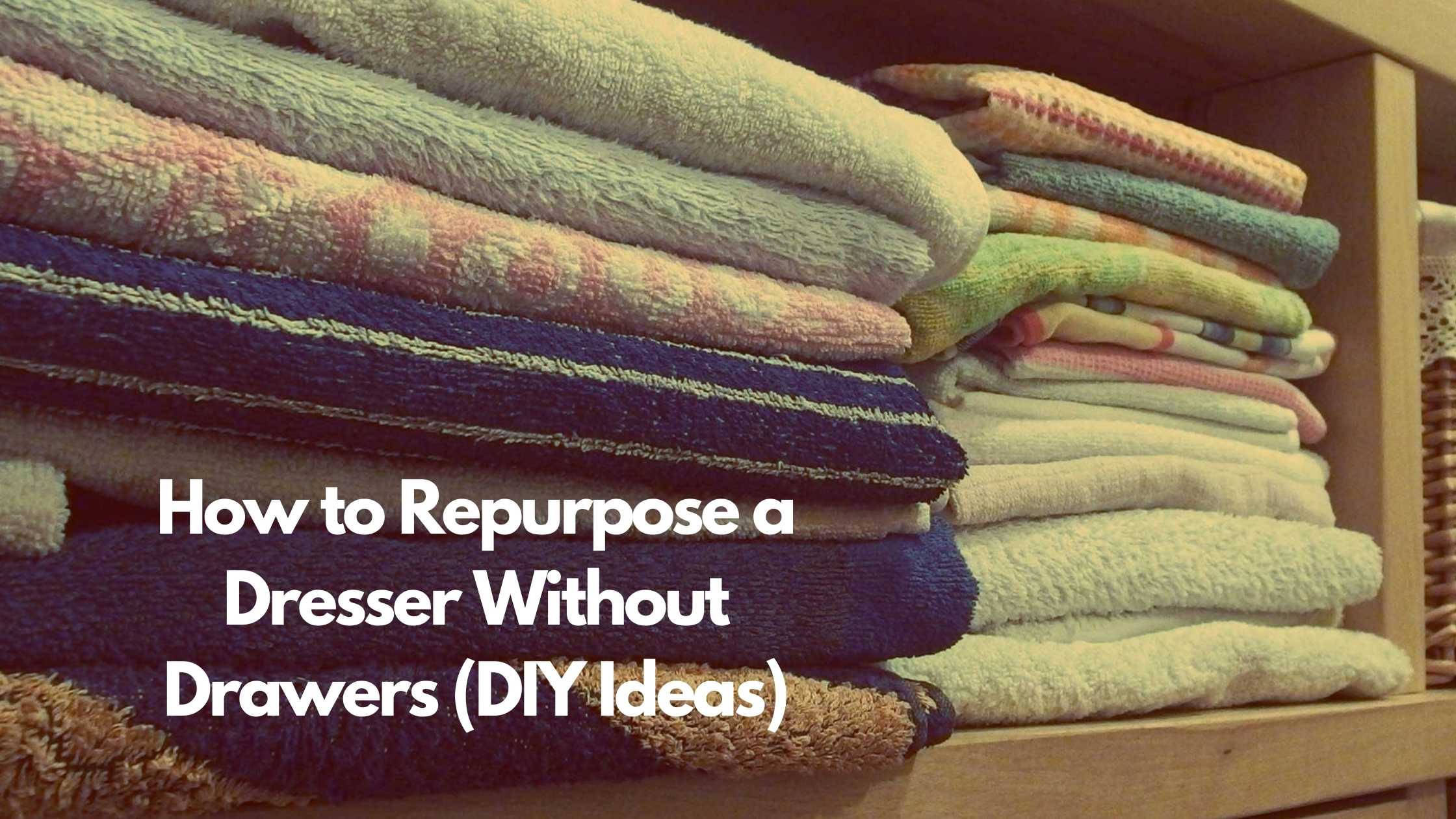
How to Repurpose a Dresser Without Drawers (DIY Ideas)

How can you repurpose a dresser without drawers? It might seem like the options are scarce, but apparently, there are plenty of ways to reuse a dresser without drawers.
You can turn it into a bookcase, TV stand, storage cabinet, or even storage bench. In fact, you’ll be surprised at the vast options, and if DIY is your thing, your excitement will spill over when you see all the possible ideas just waiting to be brought to life.
All said and done, here is a comprehensive article detailing DIY ideas you need to know on how to repurpose a dresser without drawers.
Tools & Materials That You’ll Need to Repurpose a Dresser Without Drawers
- Non-abrasive soap and lint-free cloth for cleaning
- Sandpaper – medium and fine grit
- Tack cloth
- Screwdrivers and screws
- Wrench (incase some hardware is nuts and bolts)
- Jigsaw
- Stain
- Sealant
- Paint
- A spray can with a nozzle or a paint sprayer
- Paintbrush
- Protective gear –respiratory mask, goggles, and gloves
- MDF boards
- Plywood
These are the basic DIY tools, and as you continue to work on repurposing furniture, you’ll discover the best tools in terms of the ones that save you time and give the best results.
- Book Case
Are you wondering whether it’s possible to turn a dresser without drawers into a bookcase? Below is the DIY step by step guide to achieving the repurposed transformation.
Begin by unscrewing and removing any supports and runners.
Thoroughly clean the entire wood surface with non-abrasive soap and microfiber cloth to get rid of accumulated dust and stains.
Then, sand it with fine-grit sandpaper, wiping off the sawdust with a tack cloth until you achieve a smooth finish.
Next, add plywood or MDF planks to create shelves as required. Use a jigsaw to cut out the corners to make it easy to fit and screw the shelves into place.
Prime the entire piece and apply two coats of your preferred paint color by spraying or using a paintbrush.
Let it dry for a couple of hours before you can use your brand new bookcase.
- TV Stand
Start by removing all the unnecessary parts.
Repair the damaged parts, smooth out unsightly flaws, and then sand lightly with medium-grit sandpaper.
Wipe off all the sawdust with a tack cloth or use a vacuum cleaner (if working outdoors).
Next, resize and adjust the fittings according to what you want. For example, get rid of the top or modify the structure to create a design that will be functional for your use.
When all the modifications are complete, prime, and paint the entire piece. Apply at least two to three coats, and don’t forget to sand in between each coat and wipe off the residue using a tack cloth. Then, apply a sealant once the paint dries after 24 hours.
It is advisable to let it dry for a couple of days, and thereafter, you can accessorize it as you please and put it to good use as intended.
- Kitchen Island
It’s unbelievable how many ideas there are for old dressers without drawers. Take a kitchen island, for instance. Who would have imagined that you could repurpose dresser drawers?
For more, here’s the guide with the DIY steps.
As is the standard, inspect for flaws and remove unwanted fittings and hardware.
Prep it by giving it a thorough wipe down with soapy water and the microfiber cloth. Ensure that it’s squeaky clean and ready for the makeover.
Sand it to achieve an even smooth surface, wipe off the sawdust with a tack cloth, and possibly vacuum.
Prime and paint the entire piece with your preferred paint. You can use a natural bristle brush, a sponge spreader, a spray can with a nozzle or spray gun, whatever delivers the finish that pleases you.
What about the shelves, have you figured that out yet? If not, get MDF boards sized to fit and fix them with wood glue, screws on the underside, and wood filler for the seams.
On the other hand, fix the dresser’s top using kitchen-friendly material like granite or marble. Get instructions on how to fix it from the seller after they’ve understood the type of surface you’re working with.
Next, attach the towel/utensil racks to the sides by marking and drilling holes, and secure them with short bolts and nuts or screws.
With all the parts attached, apply the second and third coats of paint, a sealant as directed, and get ready to enjoy your new kitchen island when it’s properly dried and cured.
- Coffee Bar
With all these DIY ideas for old drawers, this could turn into a hobby –seriously. Think of all the dressers without drawers sitting in some garage gathering dust, not aware of the potential they have to be gorgeous pieces of furniture. If you’d like to know whether this would be a profitable venture worth considering, read this article.
There is no shortage of ideas for old dressers without drawers. Here is another one on how to turn your dresser into a coffee bar.
You need to check for flaws and set aside the parts you don’t need for this transformation.
It’s not mandatory to sand, but it’s essential. Sand and wipe off all residue at each point with a clean, fresh tack cloth.
If you’ve achieved a satisfactory smooth surface, why not be adventurous and apply a stain? For this, apply a pre-stain wood conditioner, then your preferred stain. Use a water-based one as it absorbs and wipes off easily.
Then, coat using stain until you achieve the desired look. Next, apply a sealant and after it’s dried as instructed, apply the paint.
The final round of application is for polyurethane wood finish, which delivers a glossy smooth finish while also ensuring durability.
- Storage Cabinet
A dresser without drawers is pretty versatile and can be repurposed into several pieces of useful furniture, for example, a storage cabinet. Here’s what you need to repurpose.
Do the prep, cleaning dirt and stains to pave the way for sanding.
Most likely, you’ll want to secure it on a wall. Is this possible? Yes, if you resize and modify it appropriately, especially if you want to attach it on the wall above ground.
Sand and wipe the residue as required, then splash three coats of paint and leave the cabinet to dry for 4 to 6 days before securing it on a wall.
Next, map out the space you want to install it.
Make a mark 137cm from the floor, and if it isn’t level, measure from the highest point. Draw a horizontal line to serve as your guide for hanging the cabinet at this 54-inch point.
You’ll need wall studs to support the weight of the cabinet, which you can locate using a stud finder.
A ledger board is critical to providing support for your cabinet during installation. Thus secure the ledger board along the hanging line, then screw it into the wall at the stud locations.
Drill and countersink two holes in each of the mounting rails inside the cabinet and drive 2.5-inch cabinet screws through the holes.
Lift the cabinets and rest them on the ledger board in their designated place. Check that they are level and precise before moving on to the next step.
Fix all the cabinet doors and hardware after you secure it on the wall.
- Office Cabinet
There is no limit to what to do with a dresser without drawers. An office cabinet is another option, and below is what you need to get things going.
You can choose to just use the repurposed dresser as is without any modification, as a recycled storage center for your items. It can be a central place where you store reusable items like shopping bags, used batteries, gadgets that you can’t give away or throw out. Other things you can store here are assorted cables, software CDs, ink cartridges, and a horde of accessories for your gadgets.
Or, you could turn it into a rolling office cabinet.
First, ensure that it doesn’t have any flaws.
Then, figure out what fittings you’ll need to complete its transformation, seeing as it’s just a dresser without drawers.
The decision on fittings to use will also depend on what you’re planning to store, and it will inform the final design of the office cabinet.
Prepare the dresser by thoroughly cleaning off all dirt, grime, and stains.
Remove any hardware that comes off easily and cover the remaining hardware using painter’s tape.
Then, spray the entire piece with a coat of primer and two coats of spray paint.
To enhance mobility, install the casters. Purchase the ones with flat bases, turn the dresser upside down, drill pilot holes for the screws, screw the caster bases to the dresser and turn it upright.
- Storage Bench
The final option for this article’s DIY ideas for old dressers is a storage bench.
Yes, you can completely transform a dresser without drawers into a bench with tons of storage space.
How?
First, do the prep work, that is, lightly sanding the surfaces and then clean off any dust or debris.
Prime it with spray paint in light sweeping coats because if you don’t, it’ll drip and force you to start all over again. Paint with two or three coats and seal as instructed.
Depending on the height of the dresser, you might need to cut it in half using a jigsaw. If you want, you can fix the back and side support boards to make the bench extra comfortable.
Alternatively, you can skip this and only opt to make a cushion for the benchtop. For this, you can use foam and dress it in a nice fabric.
Finally, for storage, install fitted drawers and the required hardware.
The Bottom Line
Ideas for old dressers without drawers are plenty, and the best part is you now know how to repurpose a dresser without drawers.
Remember, your dresser can be repurposed to:
- A Bookcase
- TV stand
- Kitchen island
- Coffee bar
- Storage cabinet
- Office cabinet
- Storage bench
These aren’t the only ones; there are plenty of others.
Instead of throwing away old or damaged furniture, explore ideas on repurposing them as you can turn them into amazing decor pieces that transform your living spaces.
And if you plan to sell the repurposed dresser, consider listing it on Sheepbuy. Here, you won’t be charged a commission on your sales and, if you’re on the free basic tier, you can have up to three active listings at any given time. If you plan to sell more items, you can consider one of the paid tiers: starter and plus. Find out more here.
TRENDING


Online Arbitrage for Beginners (Step-by-Step Guide)

17 Types of Arbitrage Strategies to Turn a Profit

Is Retail Arbitrage Legal?

How to Turn Textbook Arbitrage into a Business for Profit

How Can You Tell if a Book is a First Edition?

What to Do With Your Jigsaw Puzzle When Finished?

